Report on Peer-to-Peer Learning and Student Independence
VerifiedAdded on 2020/05/16
|9
|2204
|32
Report
AI Summary
This report delves into the concept of peer-to-peer learning, highlighting its role in fostering student independence and enhancing their academic performance. It explores the features of this learning approach, emphasizing its positive impact on self-evaluation, confidence levels, and the acquisition of new skills. The report also addresses the challenges associated with peer-to-peer learning, such as potential conflicts and the lack of experienced guidance. Furthermore, it provides recommendations for effectively implementing this method, including early-stage activities and the integration of traditional learning approaches. The report concludes by emphasizing the overall effectiveness of peer-to-peer learning in promoting knowledge acquisition and skill development, ultimately leading to improved student outcomes. The report is a valuable resource for students, providing insights into the benefits and challenges of peer-to-peer learning, and is available on Desklib, a platform offering past papers and solved assignments to aid students in their studies.

Running head: Peer to Peer learning
Peer to Peer learning
Peer to Peer learning
Paraphrase This Document
Need a fresh take? Get an instant paraphrase of this document with our AI Paraphraser
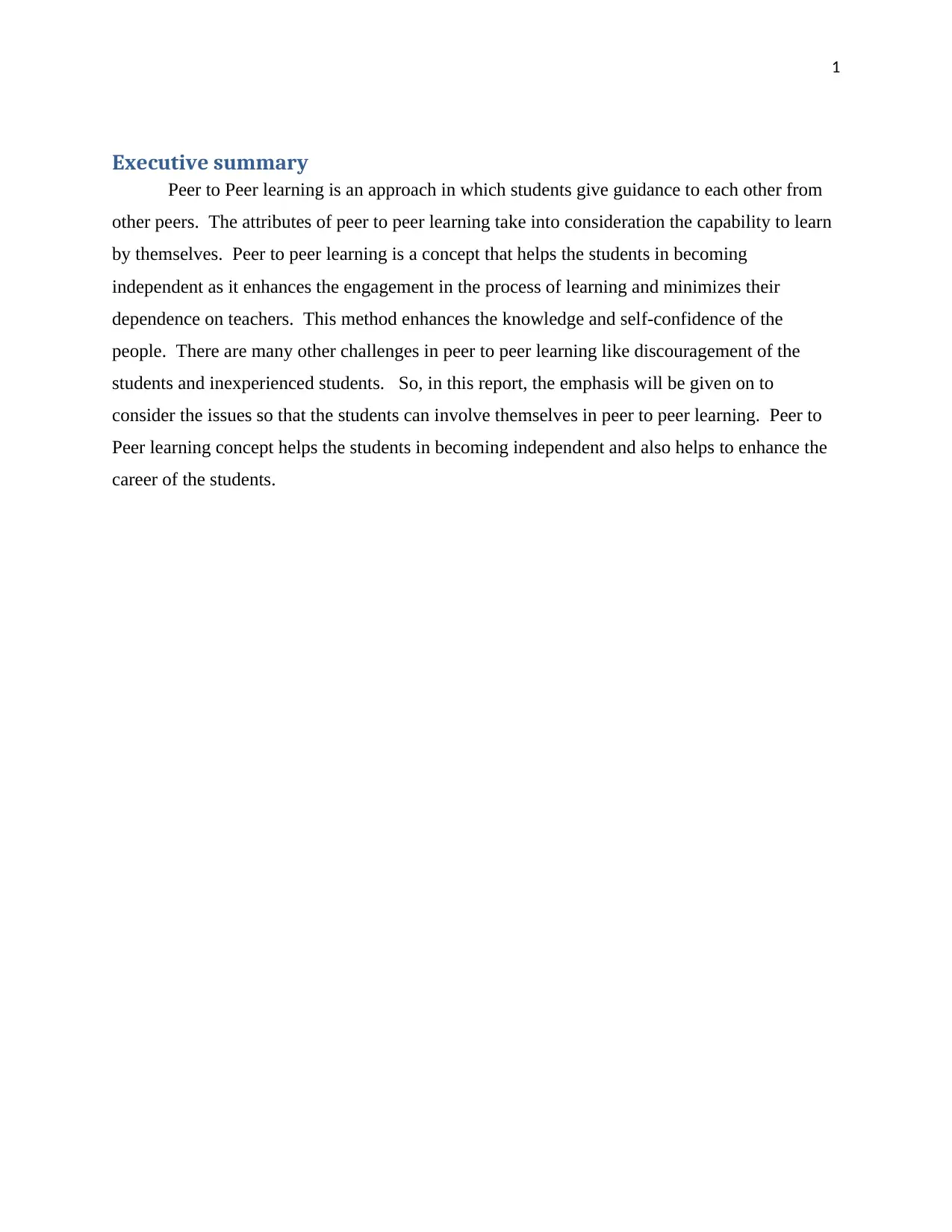
1
Executive summary
Peer to Peer learning is an approach in which students give guidance to each other from
other peers. The attributes of peer to peer learning take into consideration the capability to learn
by themselves. Peer to peer learning is a concept that helps the students in becoming
independent as it enhances the engagement in the process of learning and minimizes their
dependence on teachers. This method enhances the knowledge and self-confidence of the
people. There are many other challenges in peer to peer learning like discouragement of the
students and inexperienced students. So, in this report, the emphasis will be given on to
consider the issues so that the students can involve themselves in peer to peer learning. Peer to
Peer learning concept helps the students in becoming independent and also helps to enhance the
career of the students.
Executive summary
Peer to Peer learning is an approach in which students give guidance to each other from
other peers. The attributes of peer to peer learning take into consideration the capability to learn
by themselves. Peer to peer learning is a concept that helps the students in becoming
independent as it enhances the engagement in the process of learning and minimizes their
dependence on teachers. This method enhances the knowledge and self-confidence of the
people. There are many other challenges in peer to peer learning like discouragement of the
students and inexperienced students. So, in this report, the emphasis will be given on to
consider the issues so that the students can involve themselves in peer to peer learning. Peer to
Peer learning concept helps the students in becoming independent and also helps to enhance the
career of the students.
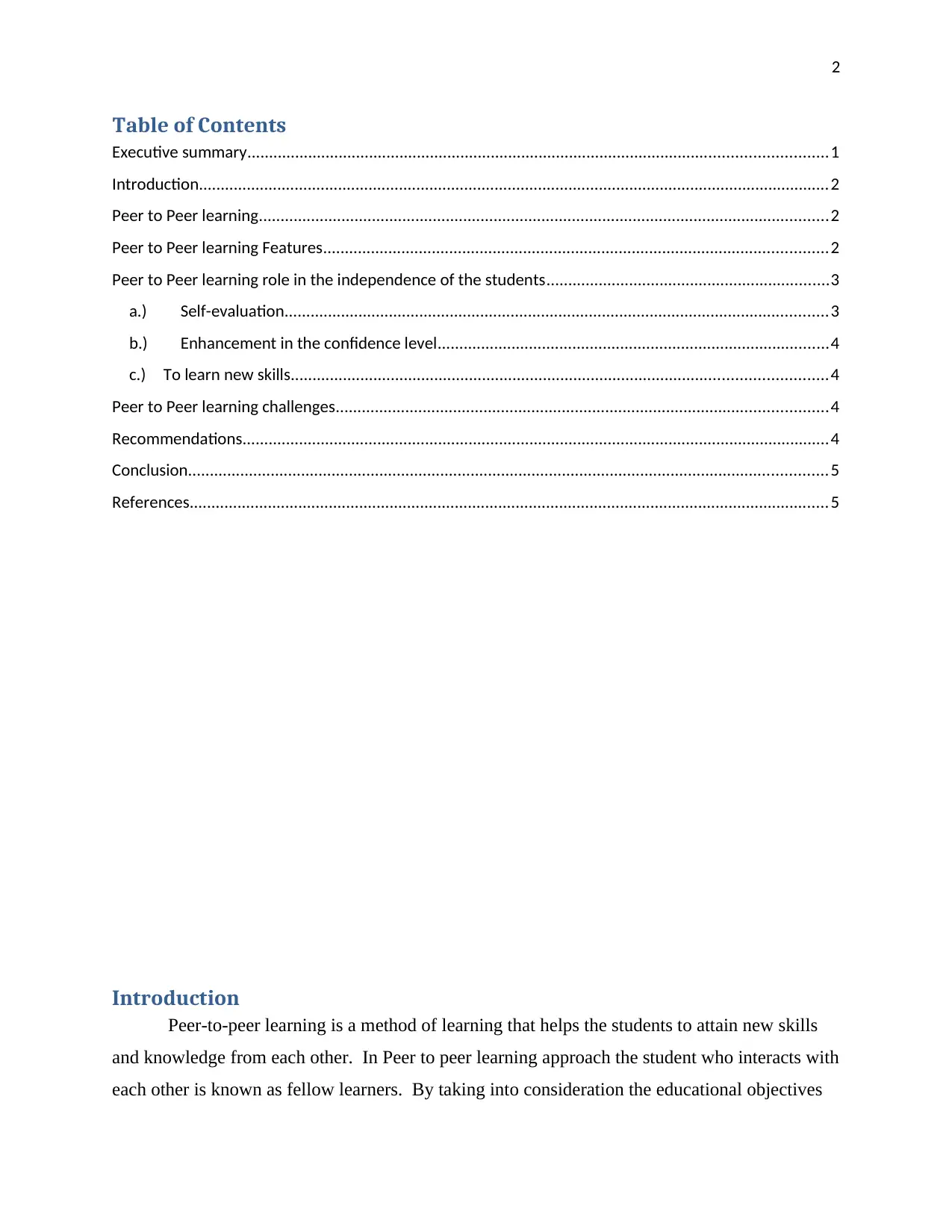
2
Table of Contents
Executive summary.....................................................................................................................................1
Introduction.................................................................................................................................................2
Peer to Peer learning...................................................................................................................................2
Peer to Peer learning Features....................................................................................................................2
Peer to Peer learning role in the independence of the students.................................................................3
a.) Self-evaluation.............................................................................................................................3
b.) Enhancement in the confidence level..........................................................................................4
c.) To learn new skills...........................................................................................................................4
Peer to Peer learning challenges.................................................................................................................4
Recommendations.......................................................................................................................................4
Conclusion...................................................................................................................................................5
References...................................................................................................................................................5
Introduction
Peer-to-peer learning is a method of learning that helps the students to attain new skills
and knowledge from each other. In Peer to peer learning approach the student who interacts with
each other is known as fellow learners. By taking into consideration the educational objectives
Table of Contents
Executive summary.....................................................................................................................................1
Introduction.................................................................................................................................................2
Peer to Peer learning...................................................................................................................................2
Peer to Peer learning Features....................................................................................................................2
Peer to Peer learning role in the independence of the students.................................................................3
a.) Self-evaluation.............................................................................................................................3
b.) Enhancement in the confidence level..........................................................................................4
c.) To learn new skills...........................................................................................................................4
Peer to Peer learning challenges.................................................................................................................4
Recommendations.......................................................................................................................................4
Conclusion...................................................................................................................................................5
References...................................................................................................................................................5
Introduction
Peer-to-peer learning is a method of learning that helps the students to attain new skills
and knowledge from each other. In Peer to peer learning approach the student who interacts with
each other is known as fellow learners. By taking into consideration the educational objectives
⊘ This is a preview!⊘
Do you want full access?
Subscribe today to unlock all pages.

Trusted by 1+ million students worldwide
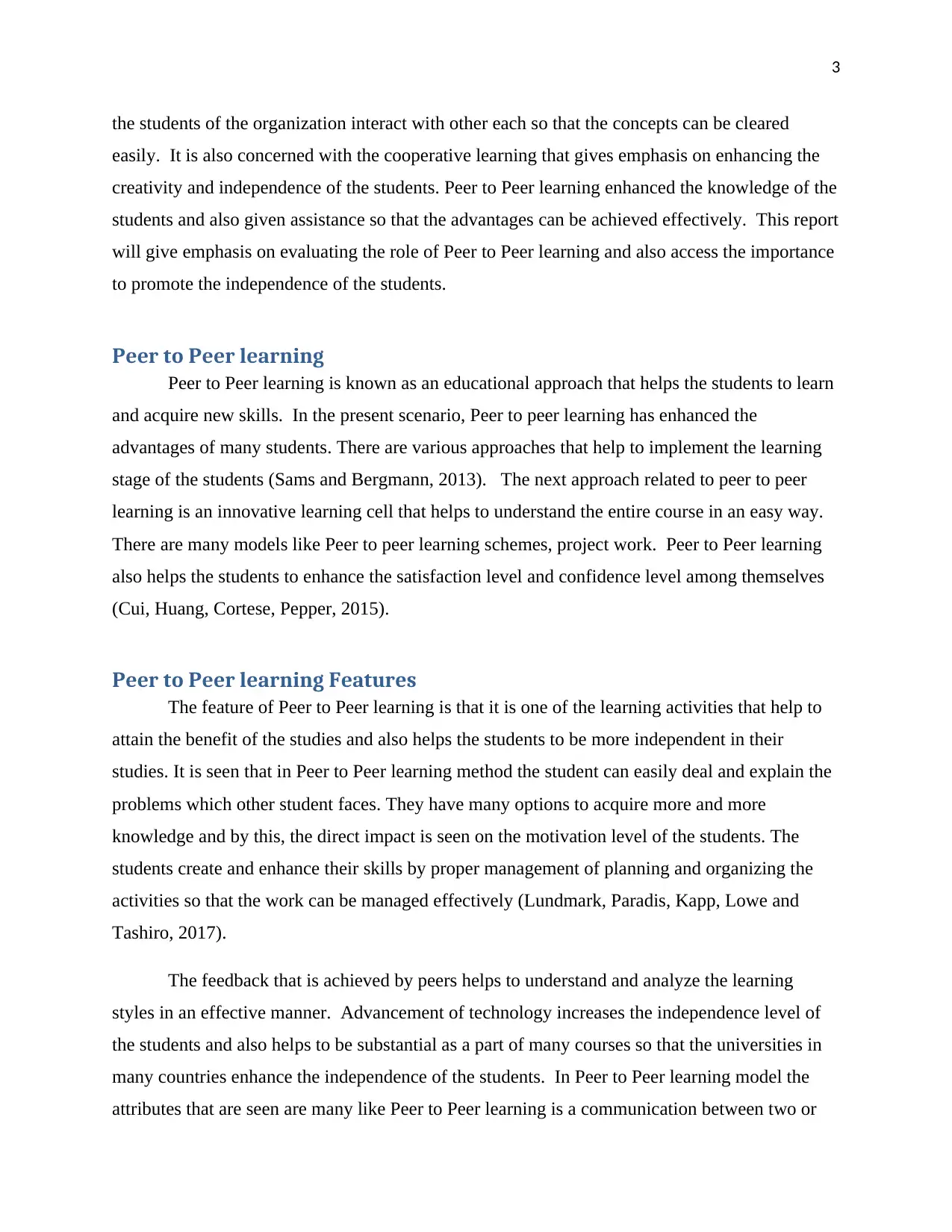
3
the students of the organization interact with other each so that the concepts can be cleared
easily. It is also concerned with the cooperative learning that gives emphasis on enhancing the
creativity and independence of the students. Peer to Peer learning enhanced the knowledge of the
students and also given assistance so that the advantages can be achieved effectively. This report
will give emphasis on evaluating the role of Peer to Peer learning and also access the importance
to promote the independence of the students.
Peer to Peer learning
Peer to Peer learning is known as an educational approach that helps the students to learn
and acquire new skills. In the present scenario, Peer to peer learning has enhanced the
advantages of many students. There are various approaches that help to implement the learning
stage of the students (Sams and Bergmann, 2013). The next approach related to peer to peer
learning is an innovative learning cell that helps to understand the entire course in an easy way.
There are many models like Peer to peer learning schemes, project work. Peer to Peer learning
also helps the students to enhance the satisfaction level and confidence level among themselves
(Cui, Huang, Cortese, Pepper, 2015).
Peer to Peer learning Features
The feature of Peer to Peer learning is that it is one of the learning activities that help to
attain the benefit of the studies and also helps the students to be more independent in their
studies. It is seen that in Peer to Peer learning method the student can easily deal and explain the
problems which other student faces. They have many options to acquire more and more
knowledge and by this, the direct impact is seen on the motivation level of the students. The
students create and enhance their skills by proper management of planning and organizing the
activities so that the work can be managed effectively (Lundmark, Paradis, Kapp, Lowe and
Tashiro, 2017).
The feedback that is achieved by peers helps to understand and analyze the learning
styles in an effective manner. Advancement of technology increases the independence level of
the students and also helps to be substantial as a part of many courses so that the universities in
many countries enhance the independence of the students. In Peer to Peer learning model the
attributes that are seen are many like Peer to Peer learning is a communication between two or
the students of the organization interact with other each so that the concepts can be cleared
easily. It is also concerned with the cooperative learning that gives emphasis on enhancing the
creativity and independence of the students. Peer to Peer learning enhanced the knowledge of the
students and also given assistance so that the advantages can be achieved effectively. This report
will give emphasis on evaluating the role of Peer to Peer learning and also access the importance
to promote the independence of the students.
Peer to Peer learning
Peer to Peer learning is known as an educational approach that helps the students to learn
and acquire new skills. In the present scenario, Peer to peer learning has enhanced the
advantages of many students. There are various approaches that help to implement the learning
stage of the students (Sams and Bergmann, 2013). The next approach related to peer to peer
learning is an innovative learning cell that helps to understand the entire course in an easy way.
There are many models like Peer to peer learning schemes, project work. Peer to Peer learning
also helps the students to enhance the satisfaction level and confidence level among themselves
(Cui, Huang, Cortese, Pepper, 2015).
Peer to Peer learning Features
The feature of Peer to Peer learning is that it is one of the learning activities that help to
attain the benefit of the studies and also helps the students to be more independent in their
studies. It is seen that in Peer to Peer learning method the student can easily deal and explain the
problems which other student faces. They have many options to acquire more and more
knowledge and by this, the direct impact is seen on the motivation level of the students. The
students create and enhance their skills by proper management of planning and organizing the
activities so that the work can be managed effectively (Lundmark, Paradis, Kapp, Lowe and
Tashiro, 2017).
The feedback that is achieved by peers helps to understand and analyze the learning
styles in an effective manner. Advancement of technology increases the independence level of
the students and also helps to be substantial as a part of many courses so that the universities in
many countries enhance the independence of the students. In Peer to Peer learning model the
attributes that are seen are many like Peer to Peer learning is a communication between two or
Paraphrase This Document
Need a fresh take? Get an instant paraphrase of this document with our AI Paraphraser
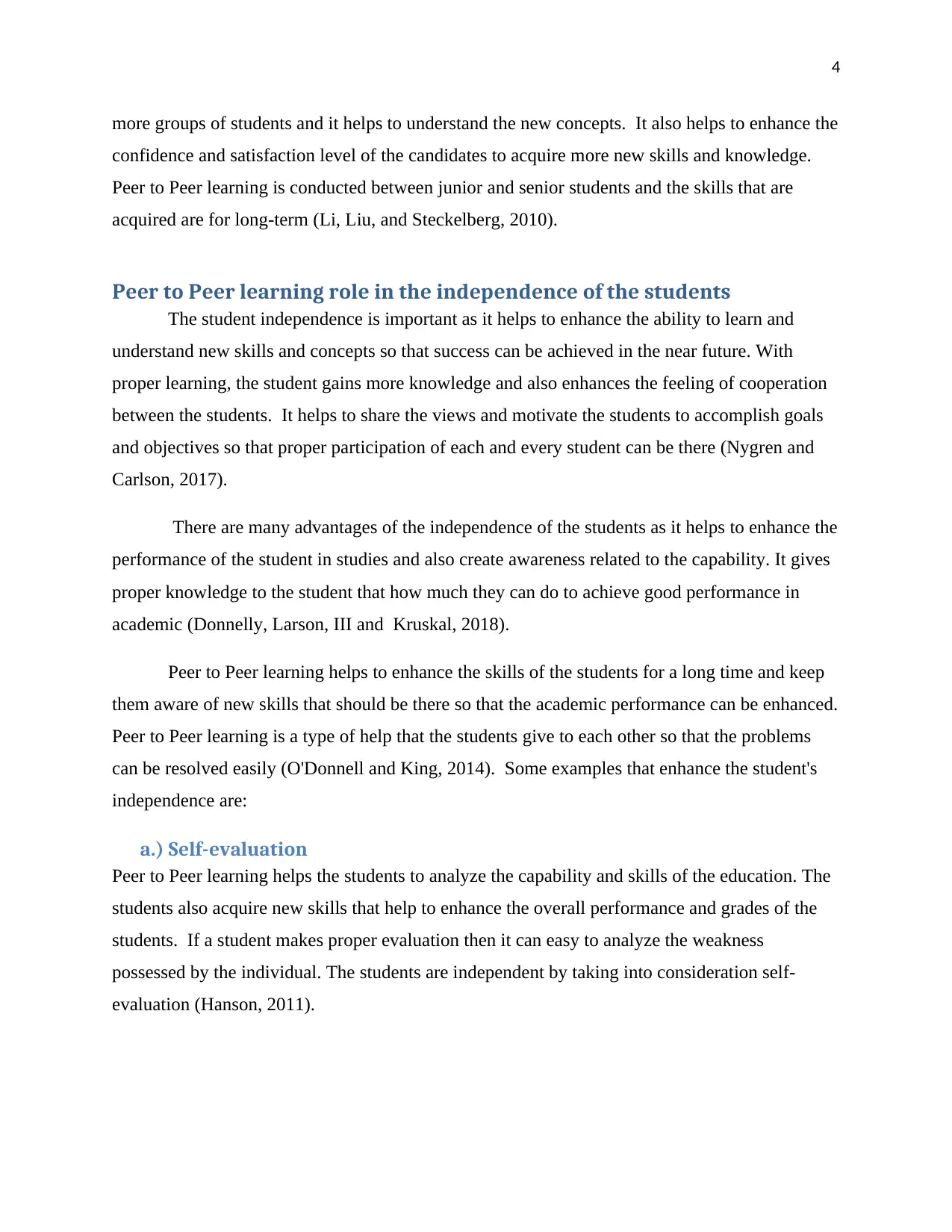
4
more groups of students and it helps to understand the new concepts. It also helps to enhance the
confidence and satisfaction level of the candidates to acquire more new skills and knowledge.
Peer to Peer learning is conducted between junior and senior students and the skills that are
acquired are for long-term (Li, Liu, and Steckelberg, 2010).
Peer to Peer learning role in the independence of the students
The student independence is important as it helps to enhance the ability to learn and
understand new skills and concepts so that success can be achieved in the near future. With
proper learning, the student gains more knowledge and also enhances the feeling of cooperation
between the students. It helps to share the views and motivate the students to accomplish goals
and objectives so that proper participation of each and every student can be there (Nygren and
Carlson, 2017).
There are many advantages of the independence of the students as it helps to enhance the
performance of the student in studies and also create awareness related to the capability. It gives
proper knowledge to the student that how much they can do to achieve good performance in
academic (Donnelly, Larson, III and Kruskal, 2018).
Peer to Peer learning helps to enhance the skills of the students for a long time and keep
them aware of new skills that should be there so that the academic performance can be enhanced.
Peer to Peer learning is a type of help that the students give to each other so that the problems
can be resolved easily (O'Donnell and King, 2014). Some examples that enhance the student's
independence are:
a.) Self-evaluation
Peer to Peer learning helps the students to analyze the capability and skills of the education. The
students also acquire new skills that help to enhance the overall performance and grades of the
students. If a student makes proper evaluation then it can easy to analyze the weakness
possessed by the individual. The students are independent by taking into consideration self-
evaluation (Hanson, 2011).
more groups of students and it helps to understand the new concepts. It also helps to enhance the
confidence and satisfaction level of the candidates to acquire more new skills and knowledge.
Peer to Peer learning is conducted between junior and senior students and the skills that are
acquired are for long-term (Li, Liu, and Steckelberg, 2010).
Peer to Peer learning role in the independence of the students
The student independence is important as it helps to enhance the ability to learn and
understand new skills and concepts so that success can be achieved in the near future. With
proper learning, the student gains more knowledge and also enhances the feeling of cooperation
between the students. It helps to share the views and motivate the students to accomplish goals
and objectives so that proper participation of each and every student can be there (Nygren and
Carlson, 2017).
There are many advantages of the independence of the students as it helps to enhance the
performance of the student in studies and also create awareness related to the capability. It gives
proper knowledge to the student that how much they can do to achieve good performance in
academic (Donnelly, Larson, III and Kruskal, 2018).
Peer to Peer learning helps to enhance the skills of the students for a long time and keep
them aware of new skills that should be there so that the academic performance can be enhanced.
Peer to Peer learning is a type of help that the students give to each other so that the problems
can be resolved easily (O'Donnell and King, 2014). Some examples that enhance the student's
independence are:
a.) Self-evaluation
Peer to Peer learning helps the students to analyze the capability and skills of the education. The
students also acquire new skills that help to enhance the overall performance and grades of the
students. If a student makes proper evaluation then it can easy to analyze the weakness
possessed by the individual. The students are independent by taking into consideration self-
evaluation (Hanson, 2011).
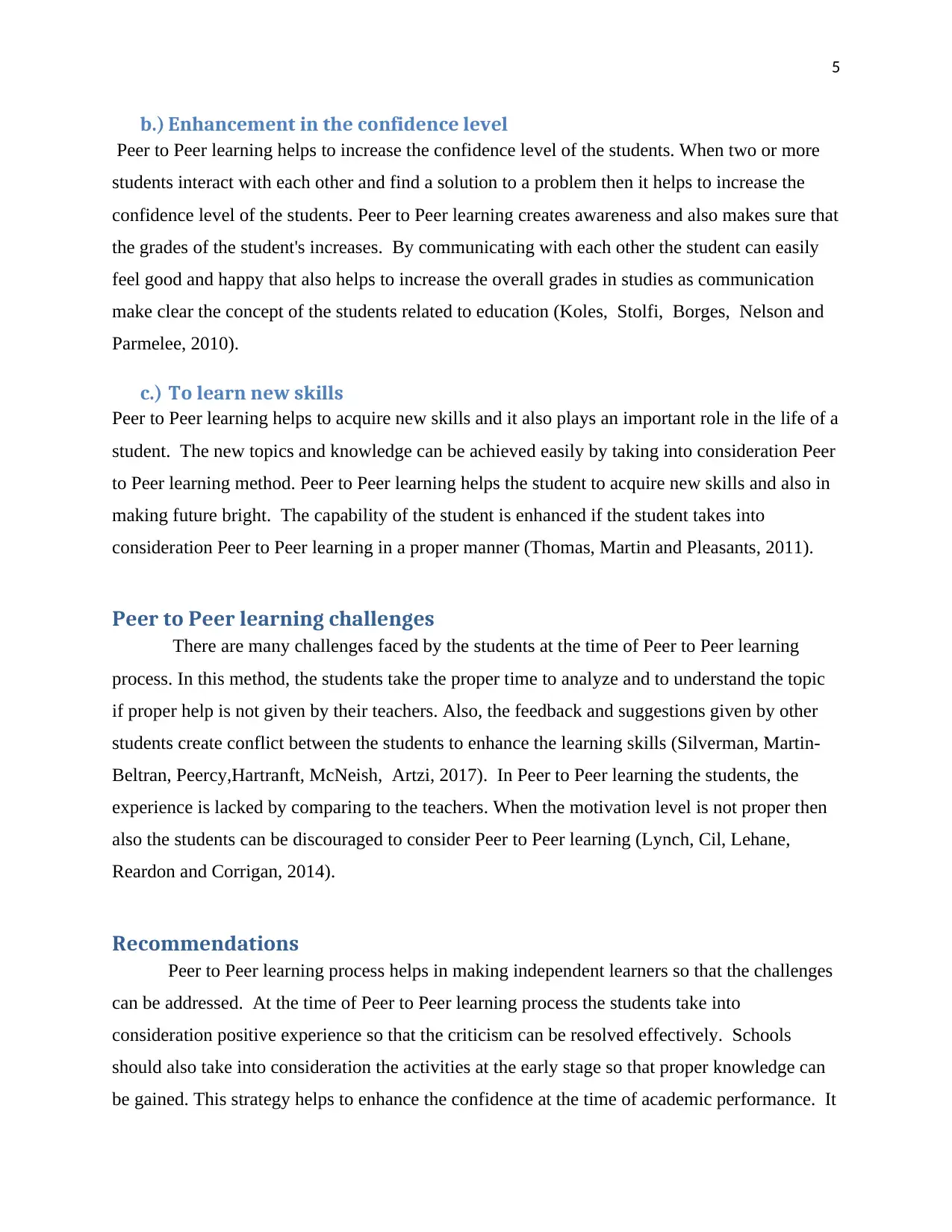
5
b.) Enhancement in the confidence level
Peer to Peer learning helps to increase the confidence level of the students. When two or more
students interact with each other and find a solution to a problem then it helps to increase the
confidence level of the students. Peer to Peer learning creates awareness and also makes sure that
the grades of the student's increases. By communicating with each other the student can easily
feel good and happy that also helps to increase the overall grades in studies as communication
make clear the concept of the students related to education (Koles, Stolfi, Borges, Nelson and
Parmelee, 2010).
c.) To learn new skills
Peer to Peer learning helps to acquire new skills and it also plays an important role in the life of a
student. The new topics and knowledge can be achieved easily by taking into consideration Peer
to Peer learning method. Peer to Peer learning helps the student to acquire new skills and also in
making future bright. The capability of the student is enhanced if the student takes into
consideration Peer to Peer learning in a proper manner (Thomas, Martin and Pleasants, 2011).
Peer to Peer learning challenges
There are many challenges faced by the students at the time of Peer to Peer learning
process. In this method, the students take the proper time to analyze and to understand the topic
if proper help is not given by their teachers. Also, the feedback and suggestions given by other
students create conflict between the students to enhance the learning skills (Silverman, Martin-
Beltran, Peercy,Hartranft, McNeish, Artzi, 2017). In Peer to Peer learning the students, the
experience is lacked by comparing to the teachers. When the motivation level is not proper then
also the students can be discouraged to consider Peer to Peer learning (Lynch, Cil, Lehane,
Reardon and Corrigan, 2014).
Recommendations
Peer to Peer learning process helps in making independent learners so that the challenges
can be addressed. At the time of Peer to Peer learning process the students take into
consideration positive experience so that the criticism can be resolved effectively. Schools
should also take into consideration the activities at the early stage so that proper knowledge can
be gained. This strategy helps to enhance the confidence at the time of academic performance. It
b.) Enhancement in the confidence level
Peer to Peer learning helps to increase the confidence level of the students. When two or more
students interact with each other and find a solution to a problem then it helps to increase the
confidence level of the students. Peer to Peer learning creates awareness and also makes sure that
the grades of the student's increases. By communicating with each other the student can easily
feel good and happy that also helps to increase the overall grades in studies as communication
make clear the concept of the students related to education (Koles, Stolfi, Borges, Nelson and
Parmelee, 2010).
c.) To learn new skills
Peer to Peer learning helps to acquire new skills and it also plays an important role in the life of a
student. The new topics and knowledge can be achieved easily by taking into consideration Peer
to Peer learning method. Peer to Peer learning helps the student to acquire new skills and also in
making future bright. The capability of the student is enhanced if the student takes into
consideration Peer to Peer learning in a proper manner (Thomas, Martin and Pleasants, 2011).
Peer to Peer learning challenges
There are many challenges faced by the students at the time of Peer to Peer learning
process. In this method, the students take the proper time to analyze and to understand the topic
if proper help is not given by their teachers. Also, the feedback and suggestions given by other
students create conflict between the students to enhance the learning skills (Silverman, Martin-
Beltran, Peercy,Hartranft, McNeish, Artzi, 2017). In Peer to Peer learning the students, the
experience is lacked by comparing to the teachers. When the motivation level is not proper then
also the students can be discouraged to consider Peer to Peer learning (Lynch, Cil, Lehane,
Reardon and Corrigan, 2014).
Recommendations
Peer to Peer learning process helps in making independent learners so that the challenges
can be addressed. At the time of Peer to Peer learning process the students take into
consideration positive experience so that the criticism can be resolved effectively. Schools
should also take into consideration the activities at the early stage so that proper knowledge can
be gained. This strategy helps to enhance the confidence at the time of academic performance. It
⊘ This is a preview!⊘
Do you want full access?
Subscribe today to unlock all pages.

Trusted by 1+ million students worldwide
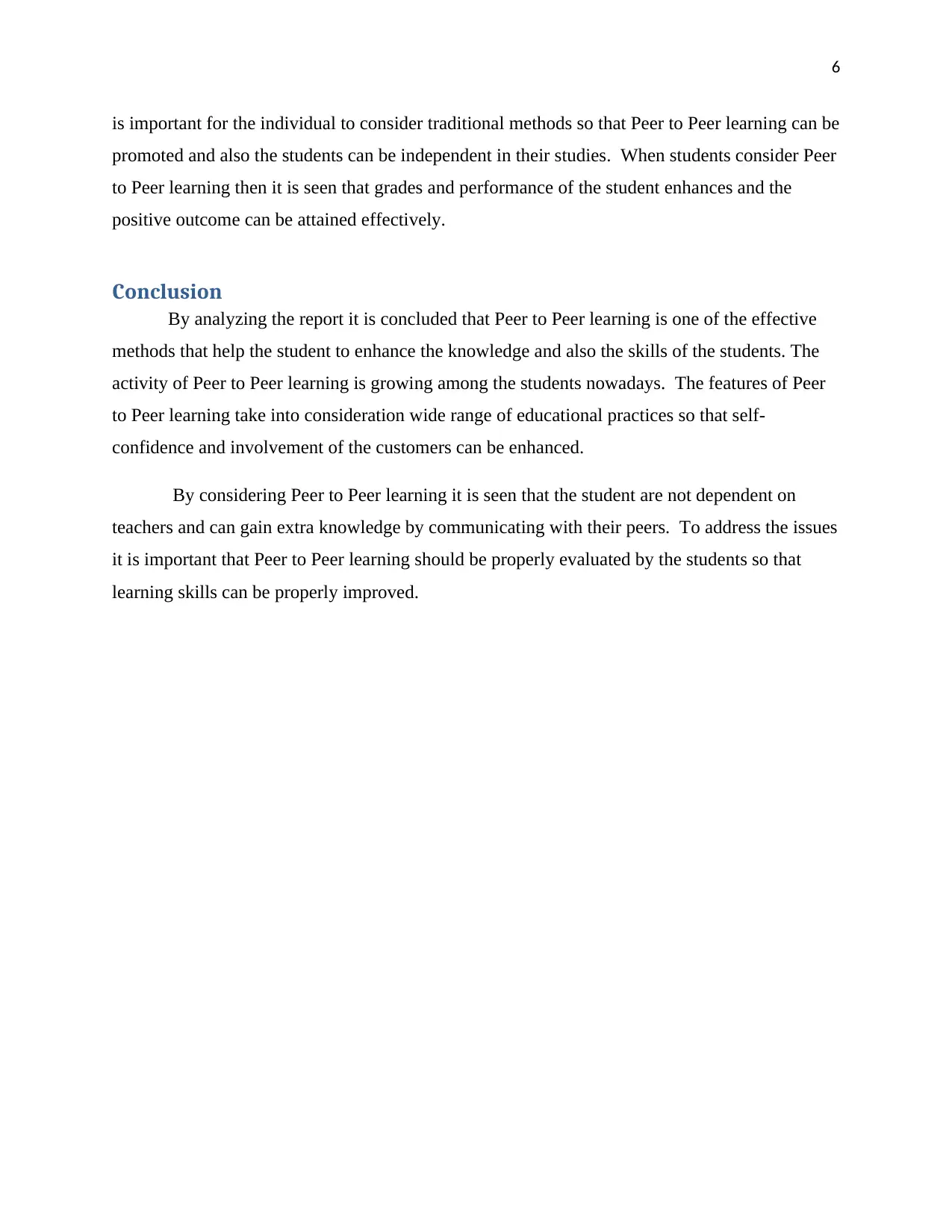
6
is important for the individual to consider traditional methods so that Peer to Peer learning can be
promoted and also the students can be independent in their studies. When students consider Peer
to Peer learning then it is seen that grades and performance of the student enhances and the
positive outcome can be attained effectively.
Conclusion
By analyzing the report it is concluded that Peer to Peer learning is one of the effective
methods that help the student to enhance the knowledge and also the skills of the students. The
activity of Peer to Peer learning is growing among the students nowadays. The features of Peer
to Peer learning take into consideration wide range of educational practices so that self-
confidence and involvement of the customers can be enhanced.
By considering Peer to Peer learning it is seen that the student are not dependent on
teachers and can gain extra knowledge by communicating with their peers. To address the issues
it is important that Peer to Peer learning should be properly evaluated by the students so that
learning skills can be properly improved.
is important for the individual to consider traditional methods so that Peer to Peer learning can be
promoted and also the students can be independent in their studies. When students consider Peer
to Peer learning then it is seen that grades and performance of the student enhances and the
positive outcome can be attained effectively.
Conclusion
By analyzing the report it is concluded that Peer to Peer learning is one of the effective
methods that help the student to enhance the knowledge and also the skills of the students. The
activity of Peer to Peer learning is growing among the students nowadays. The features of Peer
to Peer learning take into consideration wide range of educational practices so that self-
confidence and involvement of the customers can be enhanced.
By considering Peer to Peer learning it is seen that the student are not dependent on
teachers and can gain extra knowledge by communicating with their peers. To address the issues
it is important that Peer to Peer learning should be properly evaluated by the students so that
learning skills can be properly improved.
Paraphrase This Document
Need a fresh take? Get an instant paraphrase of this document with our AI Paraphraser
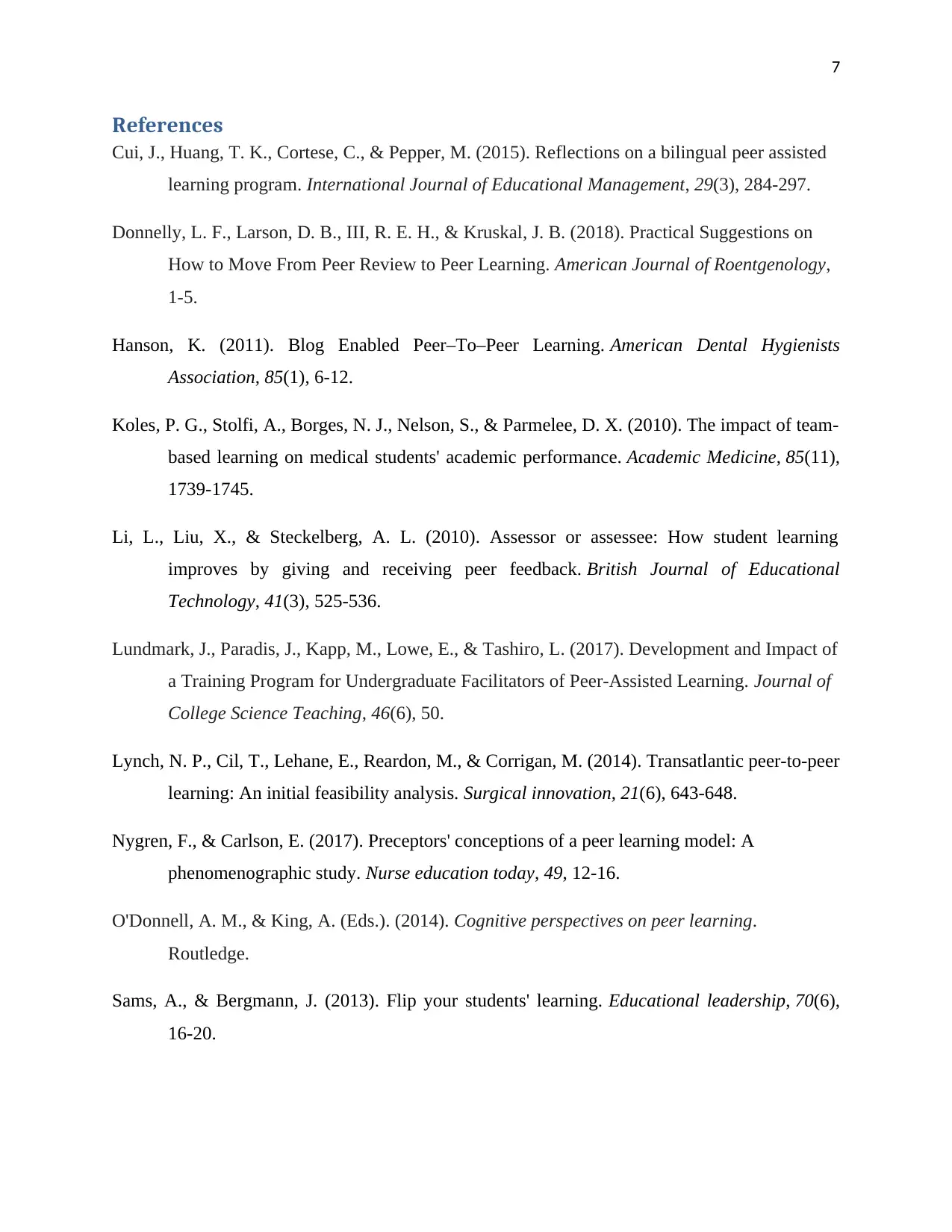
7
References
Cui, J., Huang, T. K., Cortese, C., & Pepper, M. (2015). Reflections on a bilingual peer assisted
learning program. International Journal of Educational Management, 29(3), 284-297.
Donnelly, L. F., Larson, D. B., III, R. E. H., & Kruskal, J. B. (2018). Practical Suggestions on
How to Move From Peer Review to Peer Learning. American Journal of Roentgenology,
1-5.
Hanson, K. (2011). Blog Enabled Peer–To–Peer Learning. American Dental Hygienists
Association, 85(1), 6-12.
Koles, P. G., Stolfi, A., Borges, N. J., Nelson, S., & Parmelee, D. X. (2010). The impact of team-
based learning on medical students' academic performance. Academic Medicine, 85(11),
1739-1745.
Li, L., Liu, X., & Steckelberg, A. L. (2010). Assessor or assessee: How student learning
improves by giving and receiving peer feedback. British Journal of Educational
Technology, 41(3), 525-536.
Lundmark, J., Paradis, J., Kapp, M., Lowe, E., & Tashiro, L. (2017). Development and Impact of
a Training Program for Undergraduate Facilitators of Peer-Assisted Learning. Journal of
College Science Teaching, 46(6), 50.
Lynch, N. P., Cil, T., Lehane, E., Reardon, M., & Corrigan, M. (2014). Transatlantic peer-to-peer
learning: An initial feasibility analysis. Surgical innovation, 21(6), 643-648.
Nygren, F., & Carlson, E. (2017). Preceptors' conceptions of a peer learning model: A
phenomenographic study. Nurse education today, 49, 12-16.
O'Donnell, A. M., & King, A. (Eds.). (2014). Cognitive perspectives on peer learning.
Routledge.
Sams, A., & Bergmann, J. (2013). Flip your students' learning. Educational leadership, 70(6),
16-20.
References
Cui, J., Huang, T. K., Cortese, C., & Pepper, M. (2015). Reflections on a bilingual peer assisted
learning program. International Journal of Educational Management, 29(3), 284-297.
Donnelly, L. F., Larson, D. B., III, R. E. H., & Kruskal, J. B. (2018). Practical Suggestions on
How to Move From Peer Review to Peer Learning. American Journal of Roentgenology,
1-5.
Hanson, K. (2011). Blog Enabled Peer–To–Peer Learning. American Dental Hygienists
Association, 85(1), 6-12.
Koles, P. G., Stolfi, A., Borges, N. J., Nelson, S., & Parmelee, D. X. (2010). The impact of team-
based learning on medical students' academic performance. Academic Medicine, 85(11),
1739-1745.
Li, L., Liu, X., & Steckelberg, A. L. (2010). Assessor or assessee: How student learning
improves by giving and receiving peer feedback. British Journal of Educational
Technology, 41(3), 525-536.
Lundmark, J., Paradis, J., Kapp, M., Lowe, E., & Tashiro, L. (2017). Development and Impact of
a Training Program for Undergraduate Facilitators of Peer-Assisted Learning. Journal of
College Science Teaching, 46(6), 50.
Lynch, N. P., Cil, T., Lehane, E., Reardon, M., & Corrigan, M. (2014). Transatlantic peer-to-peer
learning: An initial feasibility analysis. Surgical innovation, 21(6), 643-648.
Nygren, F., & Carlson, E. (2017). Preceptors' conceptions of a peer learning model: A
phenomenographic study. Nurse education today, 49, 12-16.
O'Donnell, A. M., & King, A. (Eds.). (2014). Cognitive perspectives on peer learning.
Routledge.
Sams, A., & Bergmann, J. (2013). Flip your students' learning. Educational leadership, 70(6),
16-20.
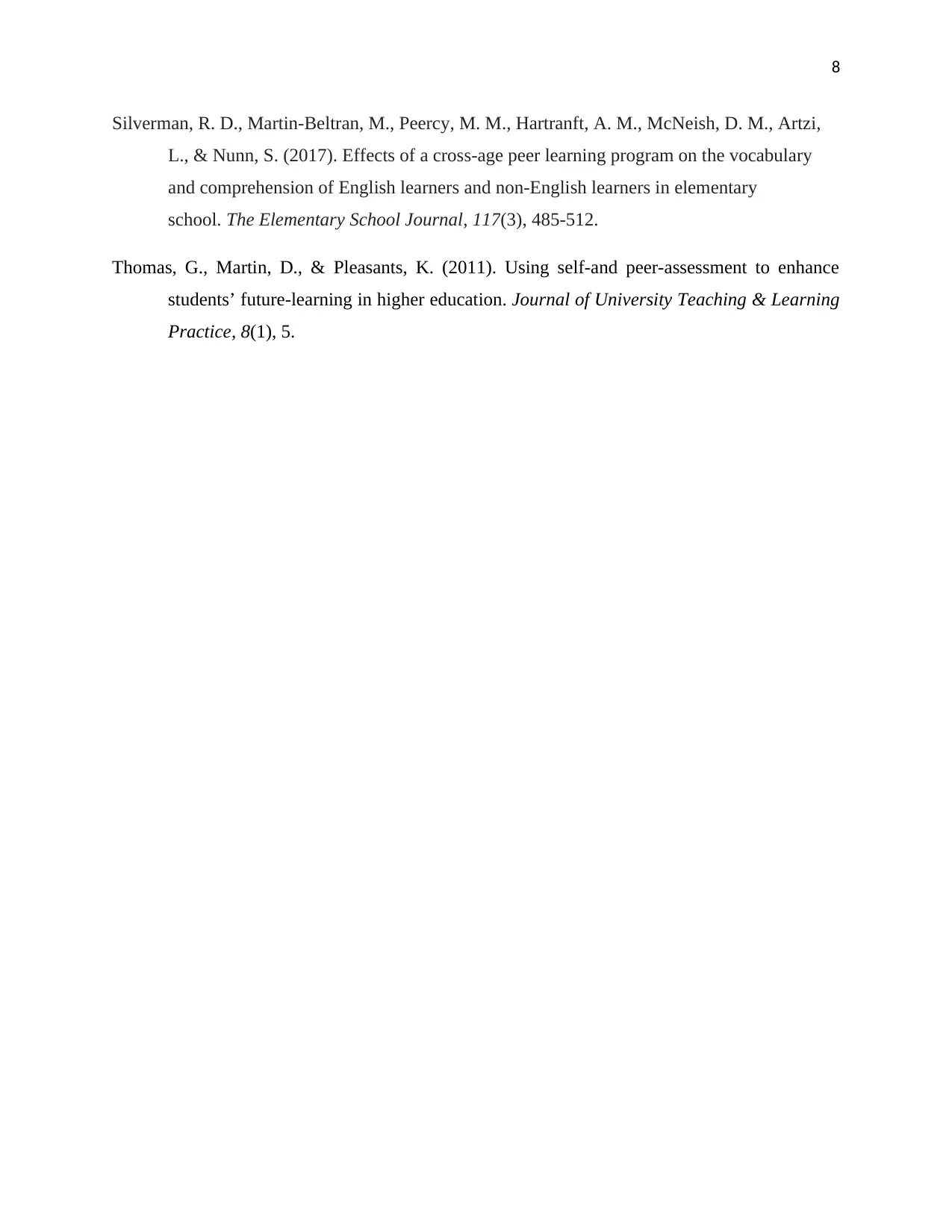
8
Silverman, R. D., Martin-Beltran, M., Peercy, M. M., Hartranft, A. M., McNeish, D. M., Artzi,
L., & Nunn, S. (2017). Effects of a cross-age peer learning program on the vocabulary
and comprehension of English learners and non-English learners in elementary
school. The Elementary School Journal, 117(3), 485-512.
Thomas, G., Martin, D., & Pleasants, K. (2011). Using self-and peer-assessment to enhance
students’ future-learning in higher education. Journal of University Teaching & Learning
Practice, 8(1), 5.
Silverman, R. D., Martin-Beltran, M., Peercy, M. M., Hartranft, A. M., McNeish, D. M., Artzi,
L., & Nunn, S. (2017). Effects of a cross-age peer learning program on the vocabulary
and comprehension of English learners and non-English learners in elementary
school. The Elementary School Journal, 117(3), 485-512.
Thomas, G., Martin, D., & Pleasants, K. (2011). Using self-and peer-assessment to enhance
students’ future-learning in higher education. Journal of University Teaching & Learning
Practice, 8(1), 5.
⊘ This is a preview!⊘
Do you want full access?
Subscribe today to unlock all pages.

Trusted by 1+ million students worldwide
1 out of 9
Related Documents
Your All-in-One AI-Powered Toolkit for Academic Success.
+13062052269
info@desklib.com
Available 24*7 on WhatsApp / Email
![[object Object]](/_next/static/media/star-bottom.7253800d.svg)
Unlock your academic potential
Copyright © 2020–2025 A2Z Services. All Rights Reserved. Developed and managed by ZUCOL.




